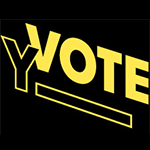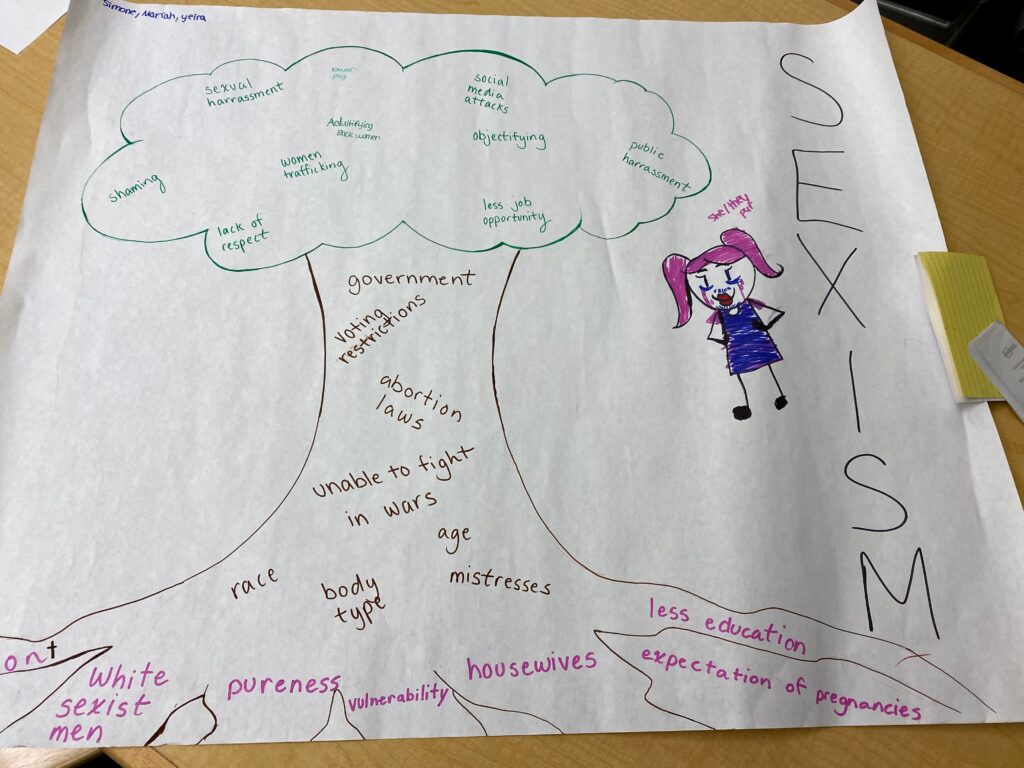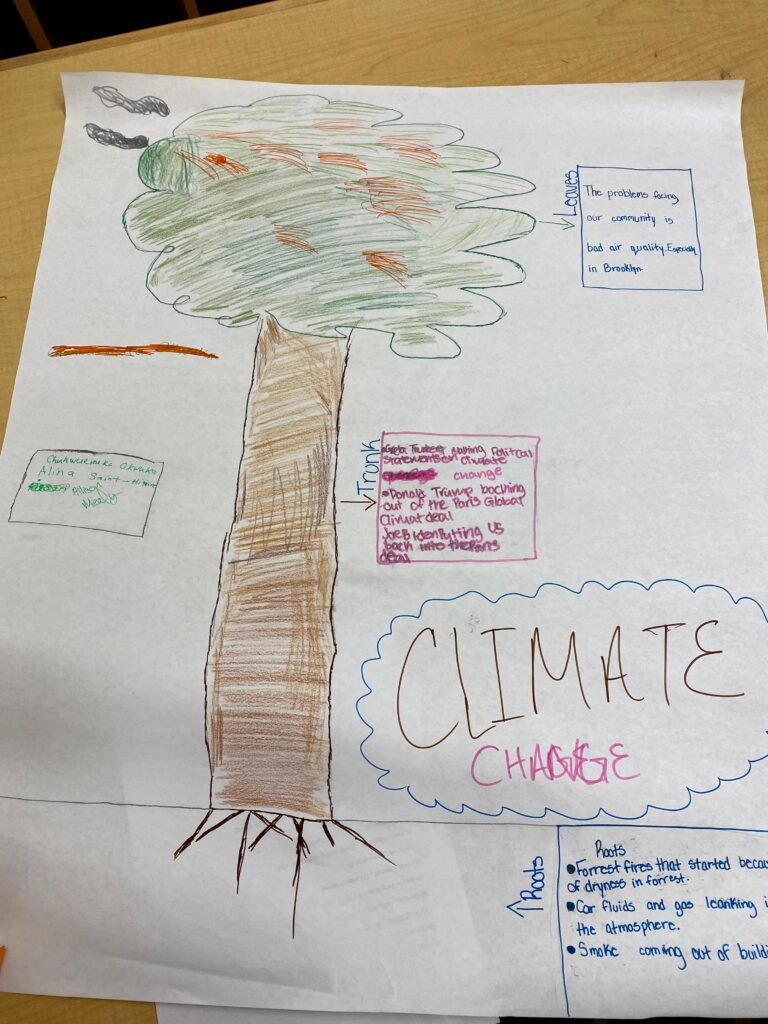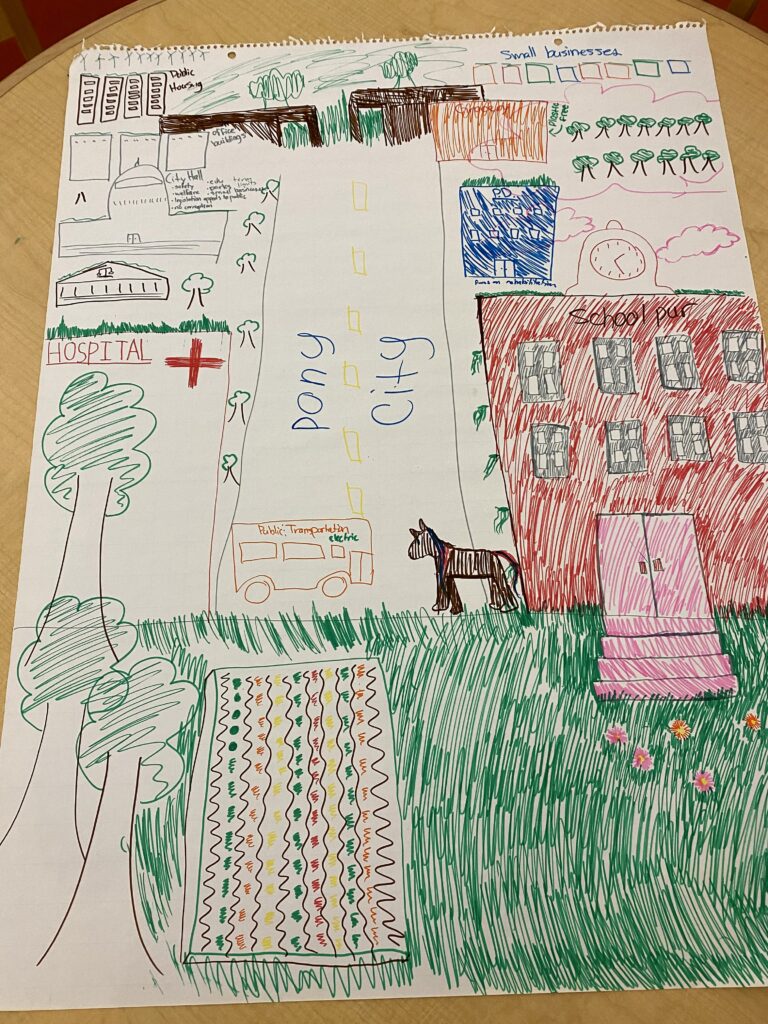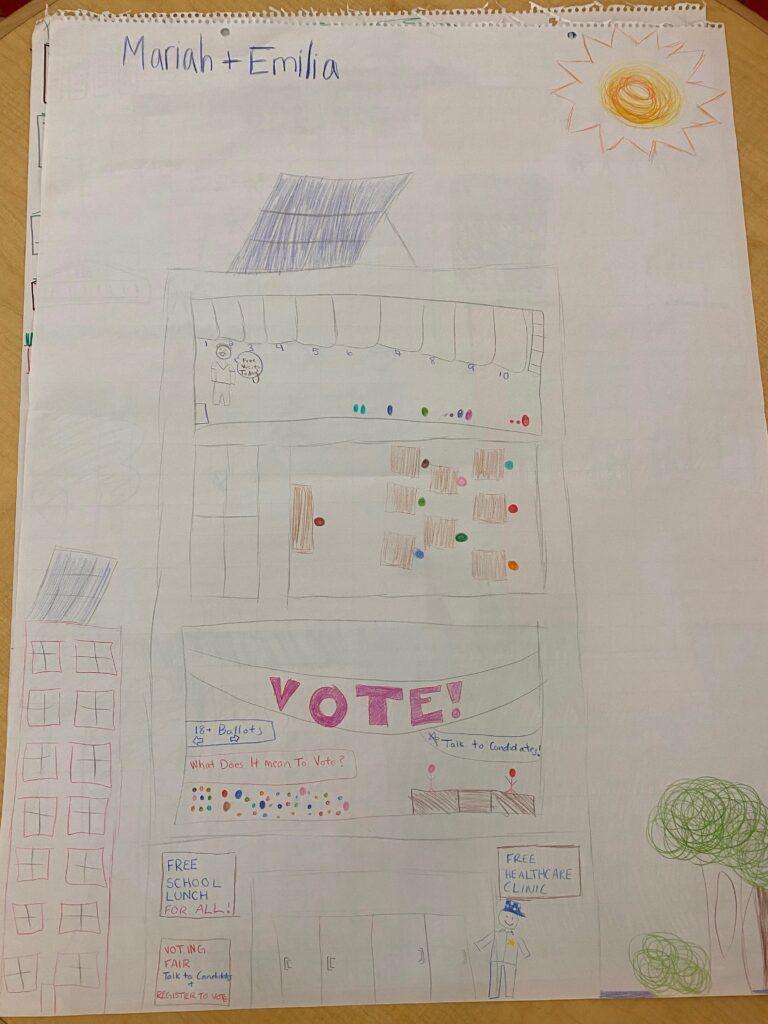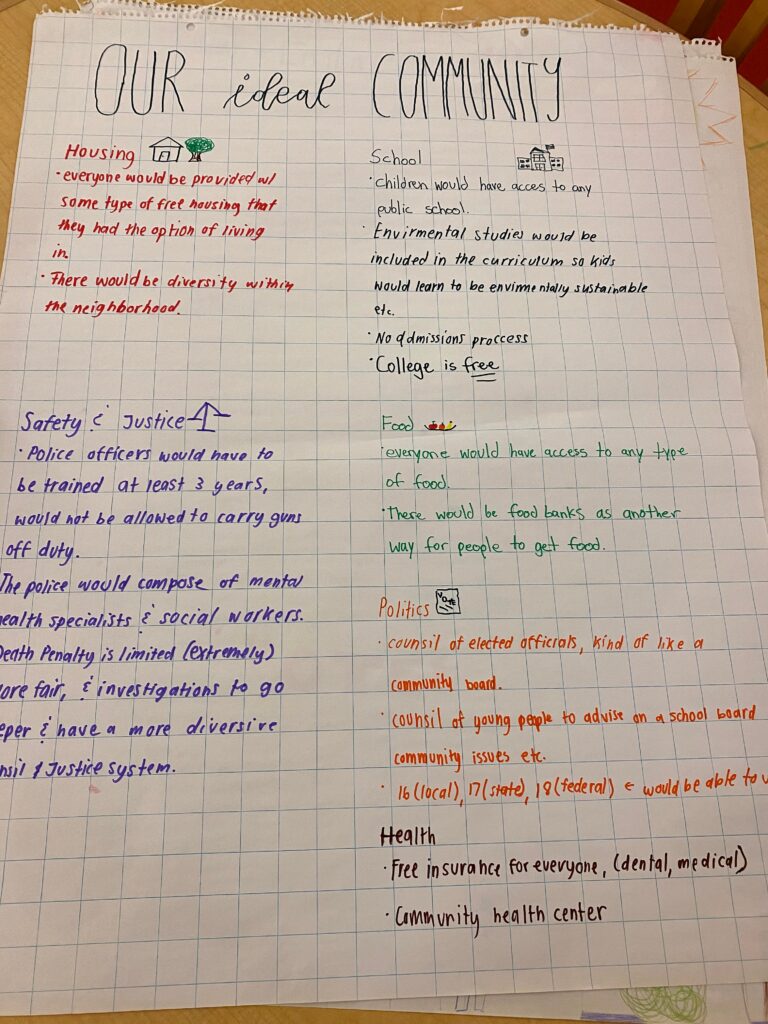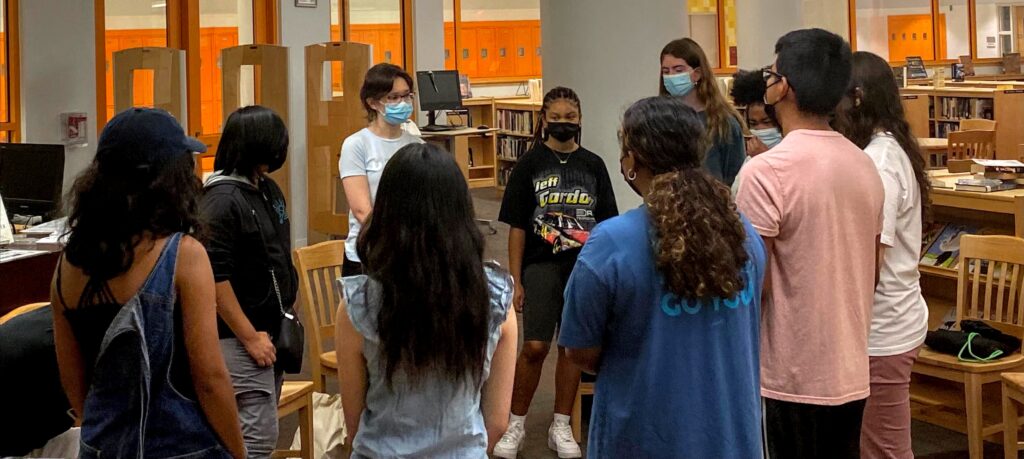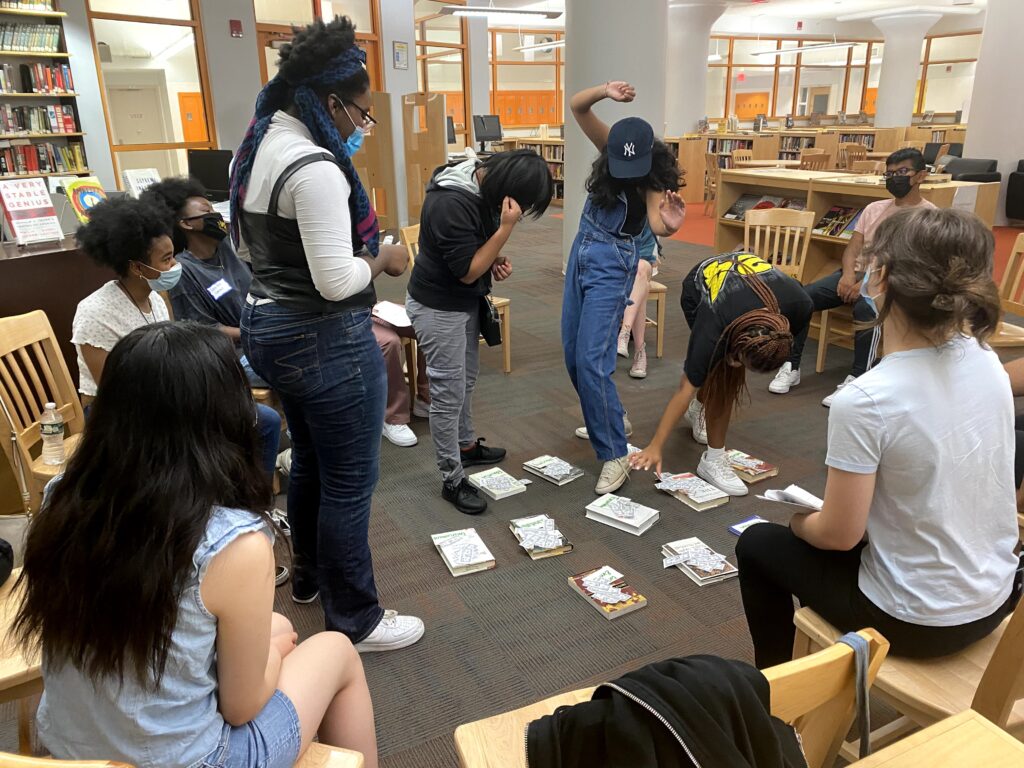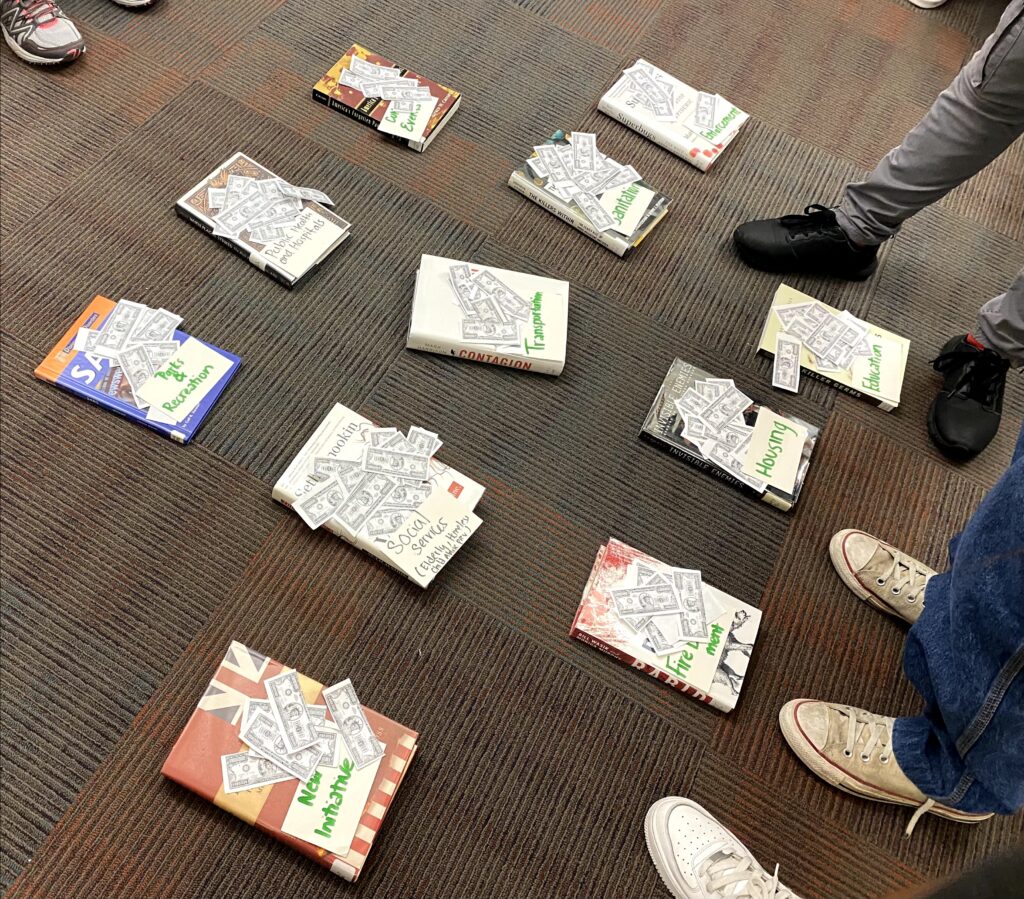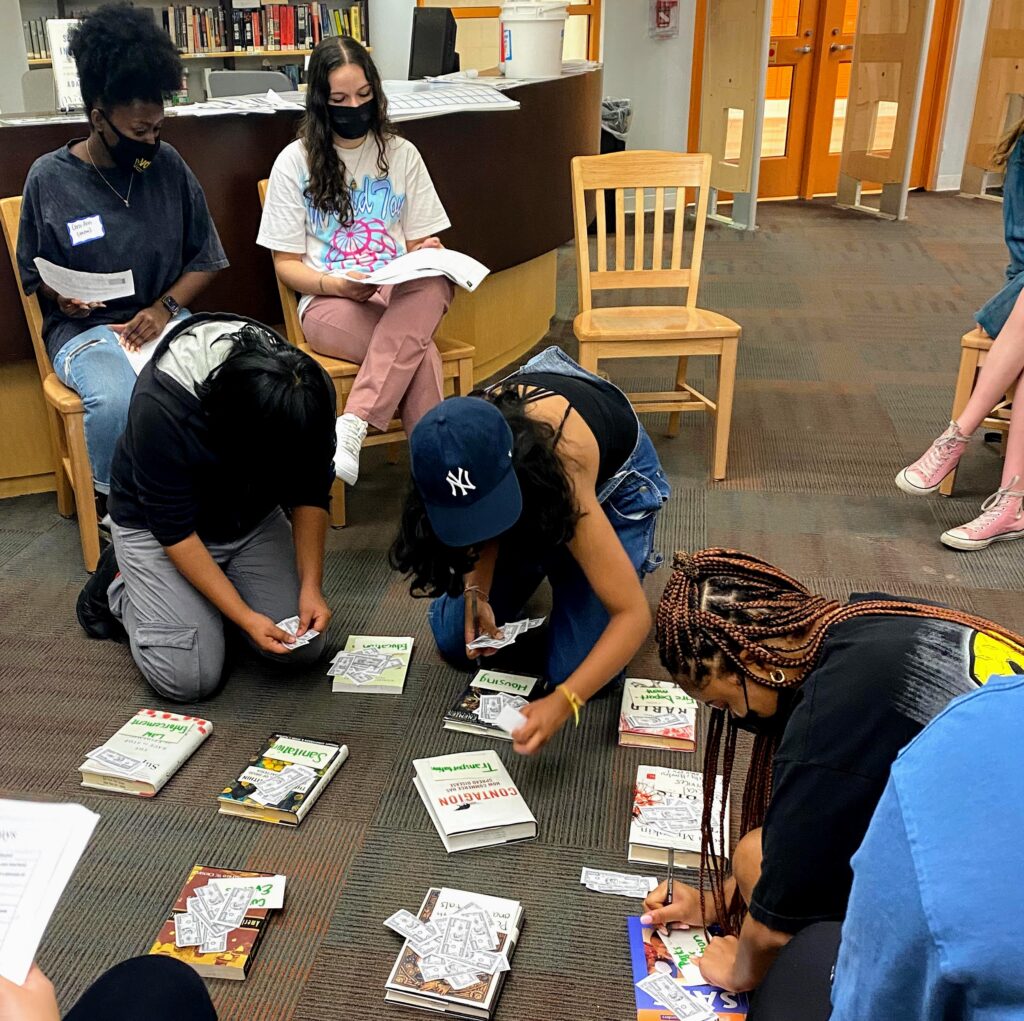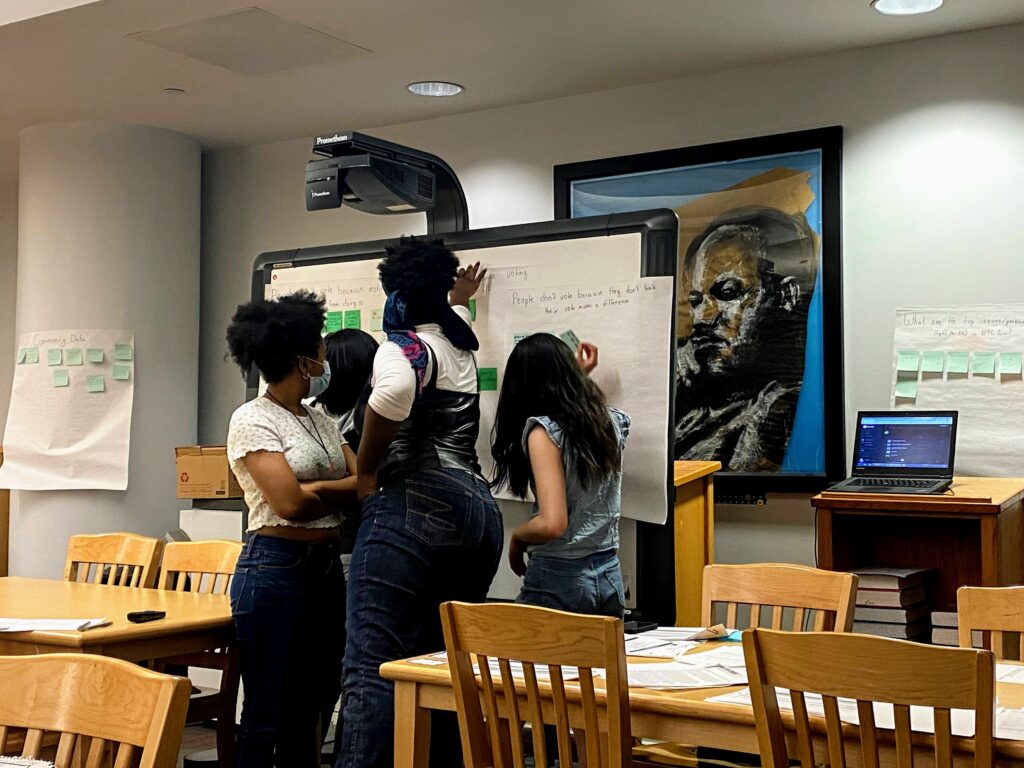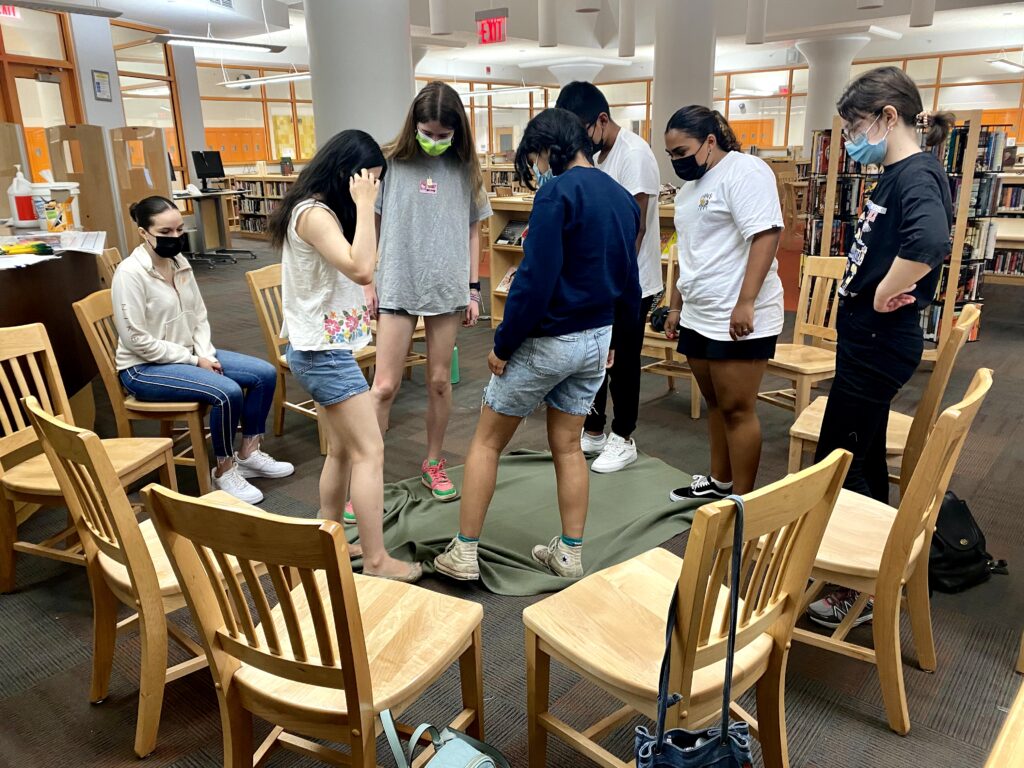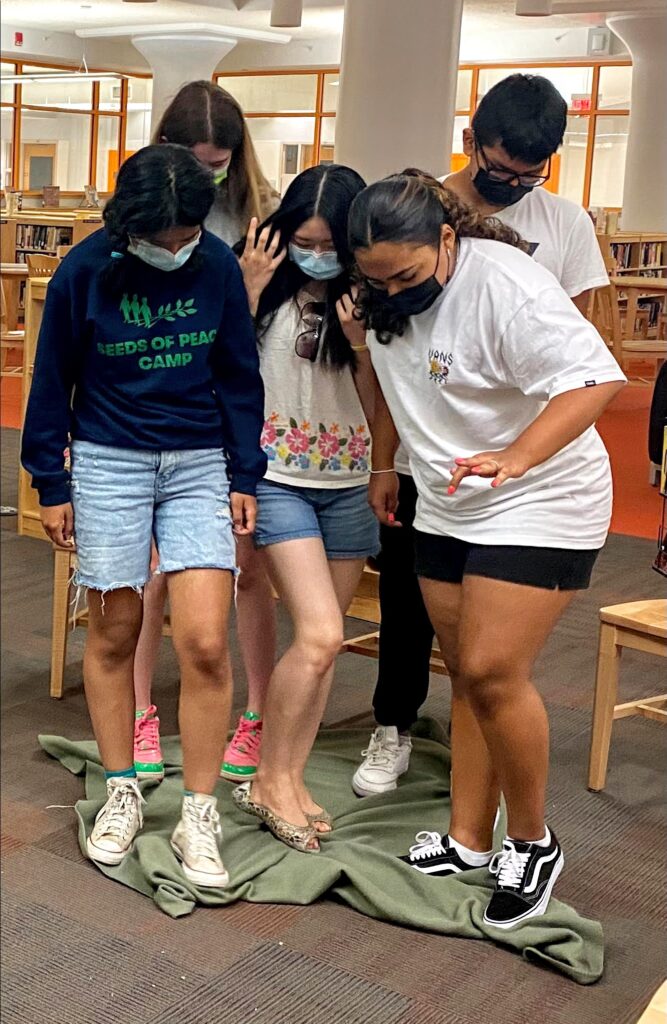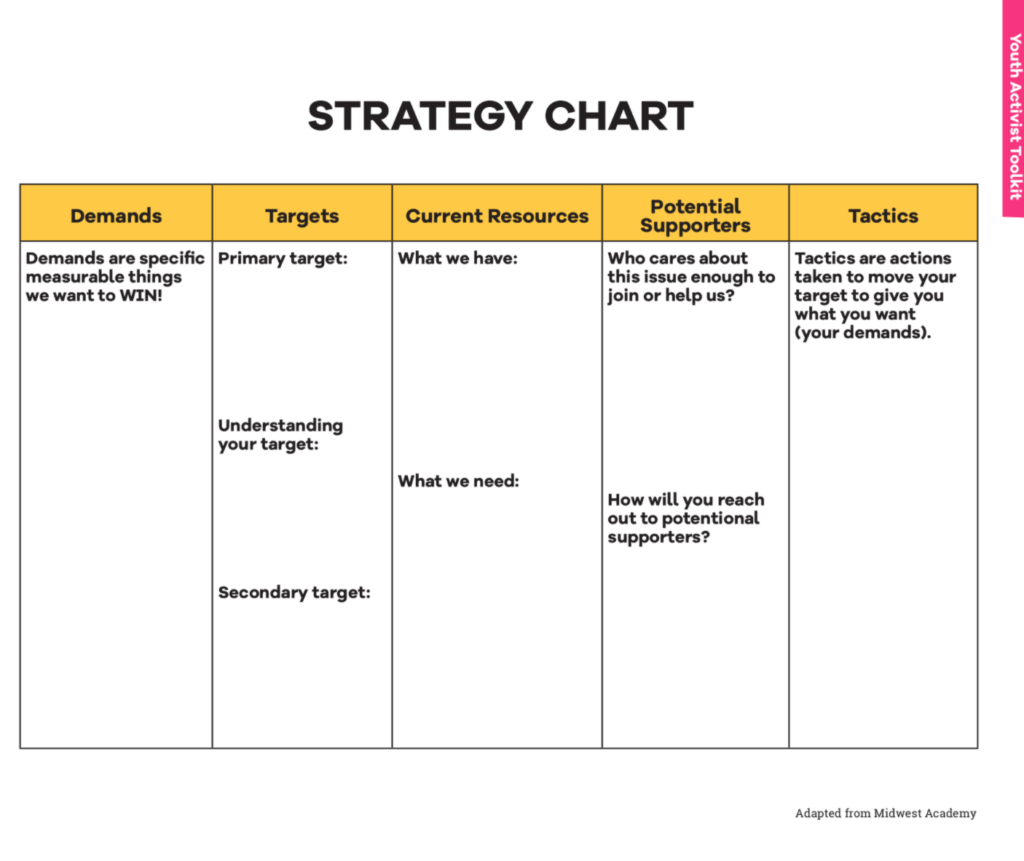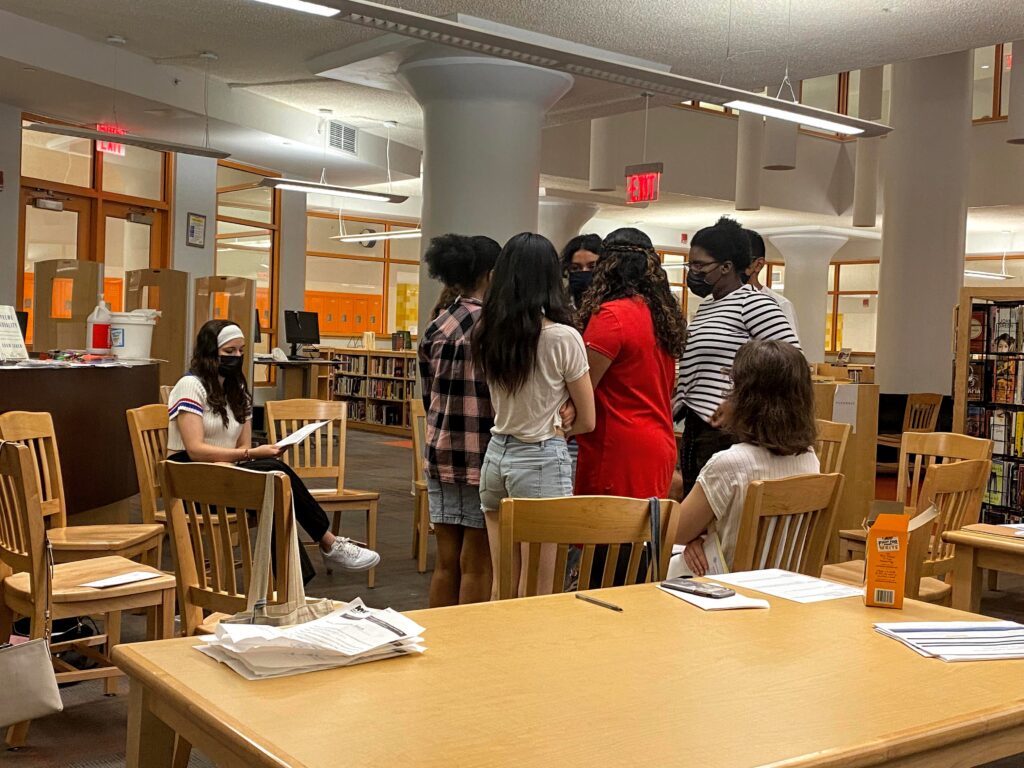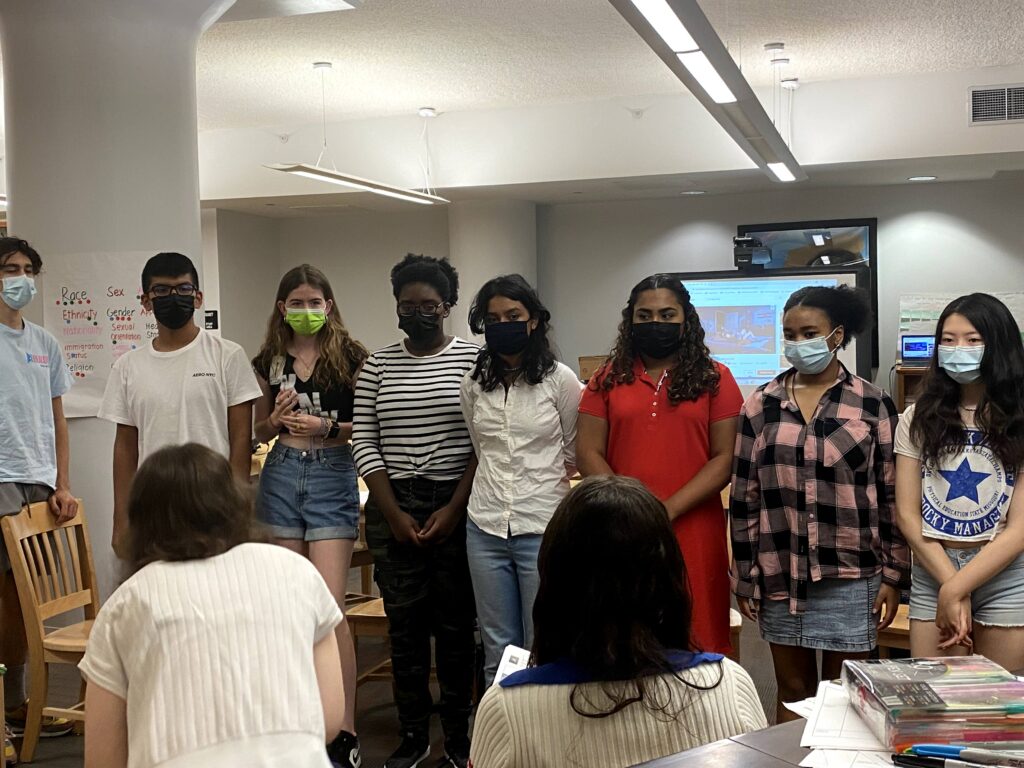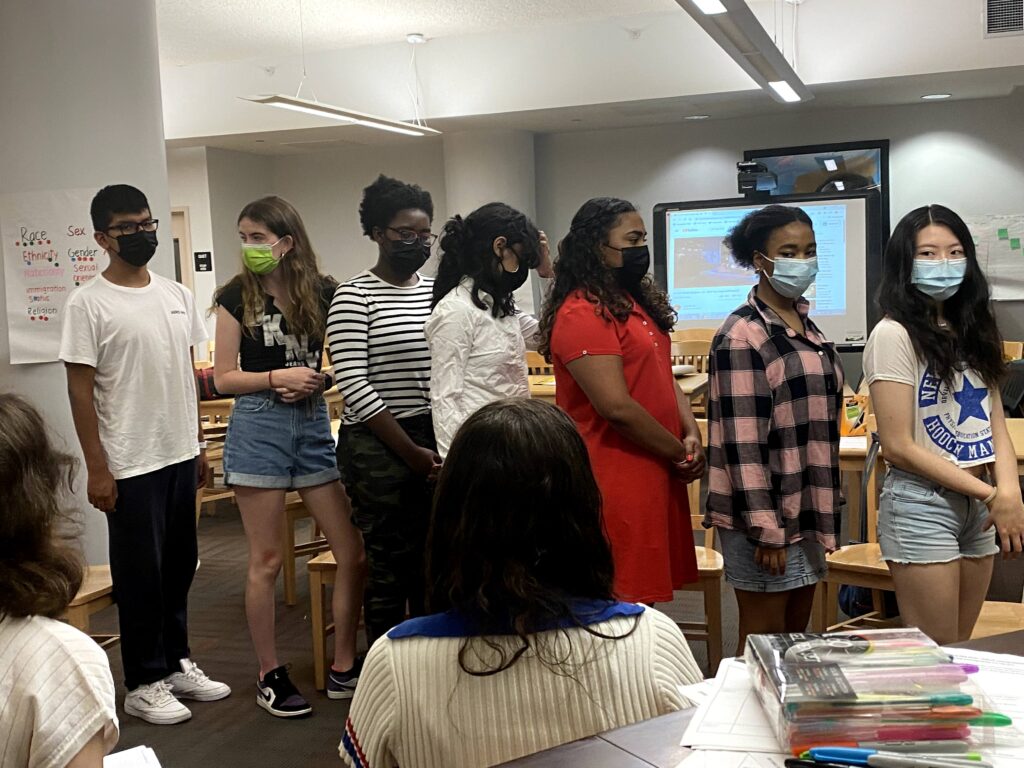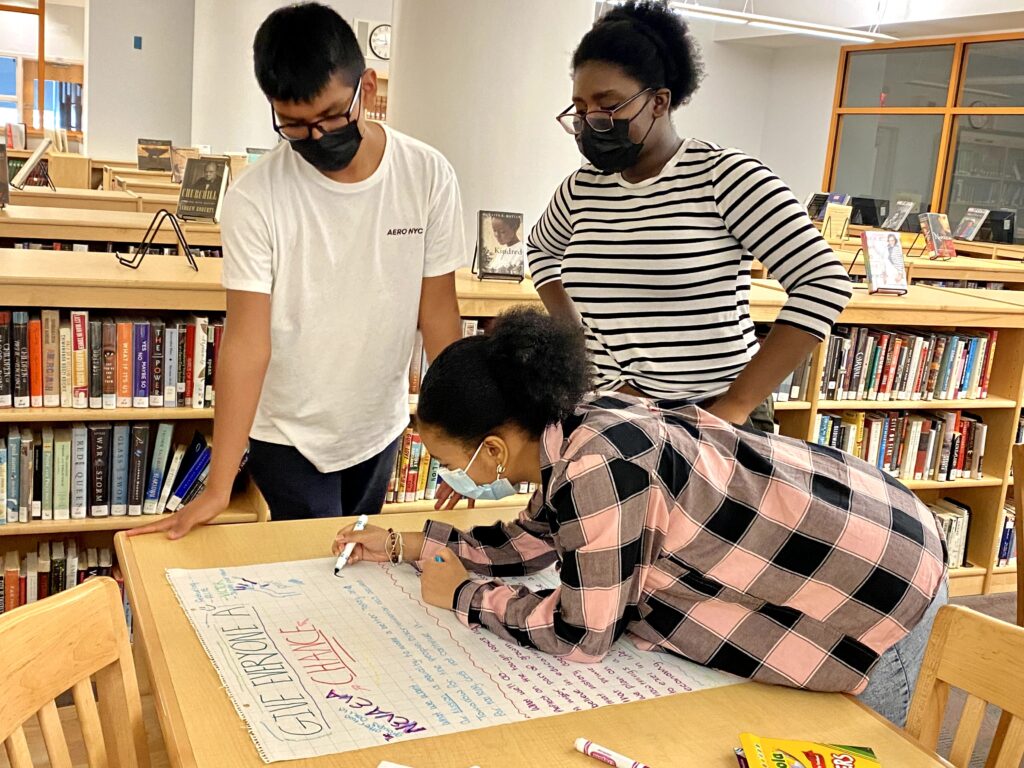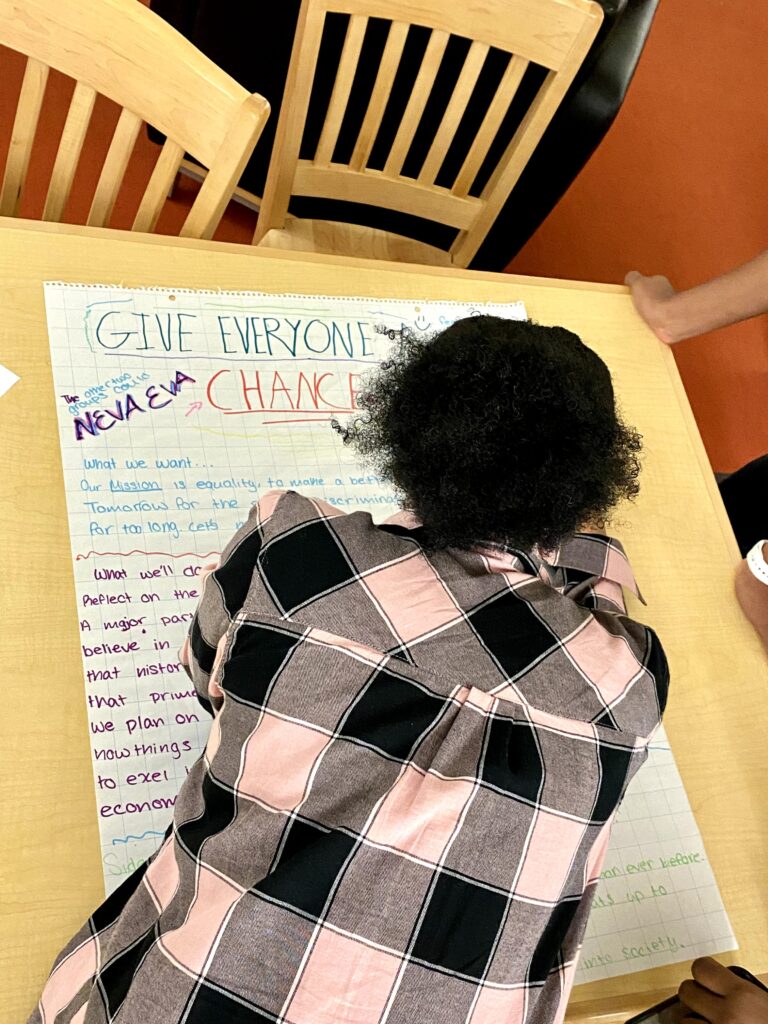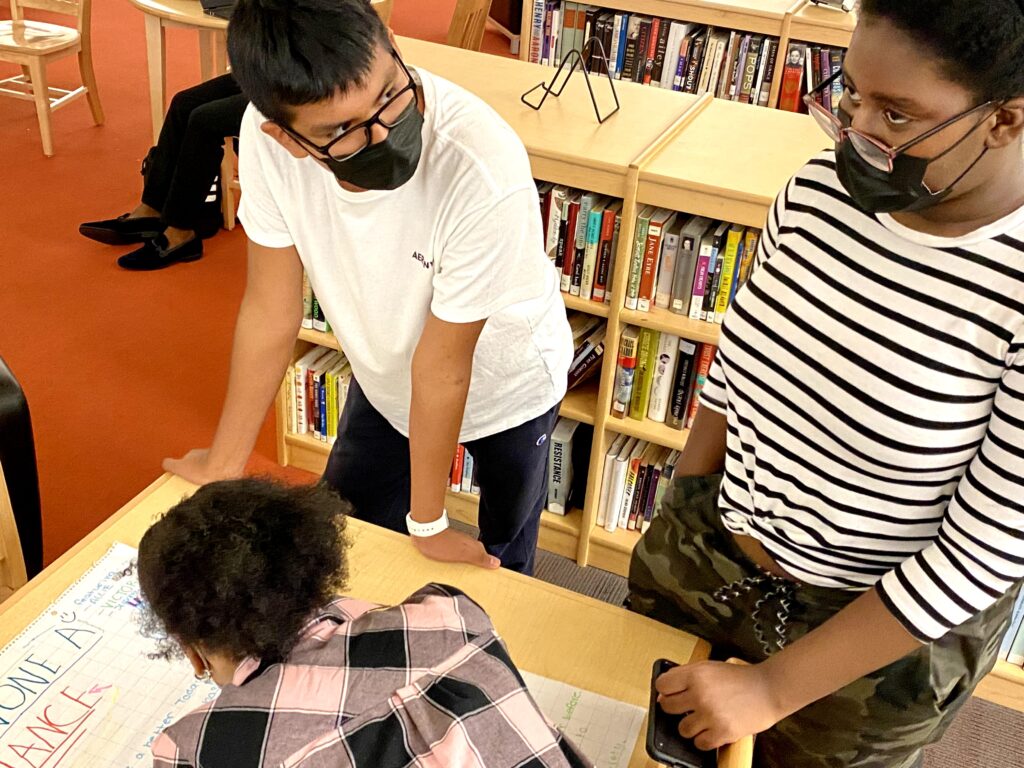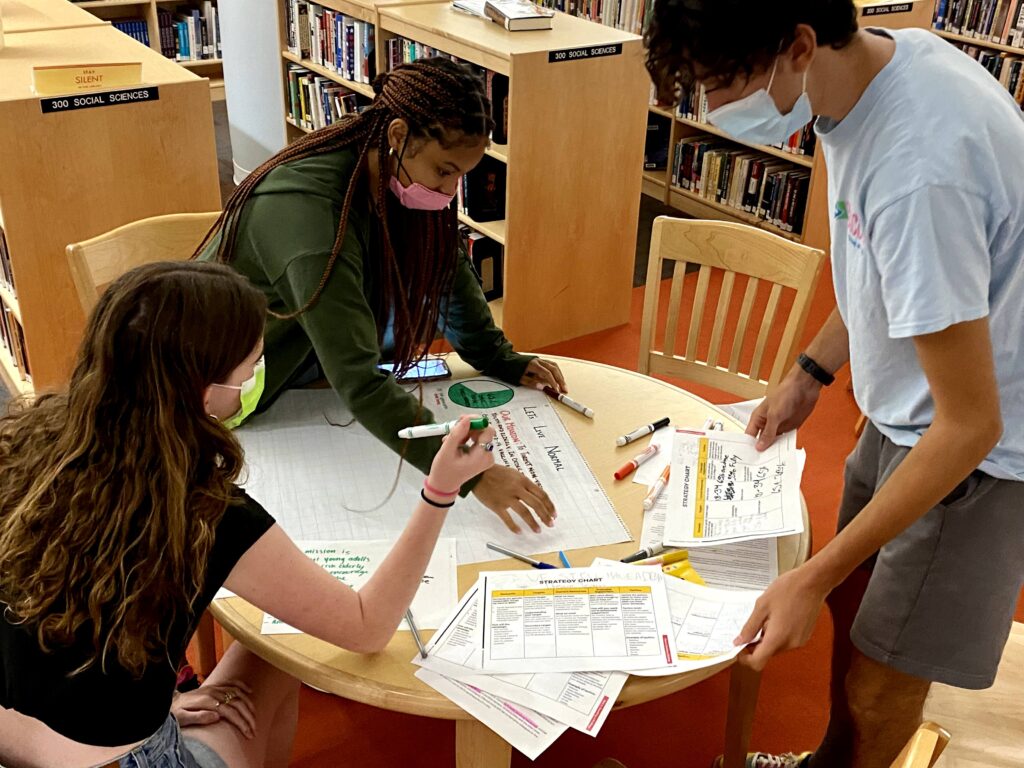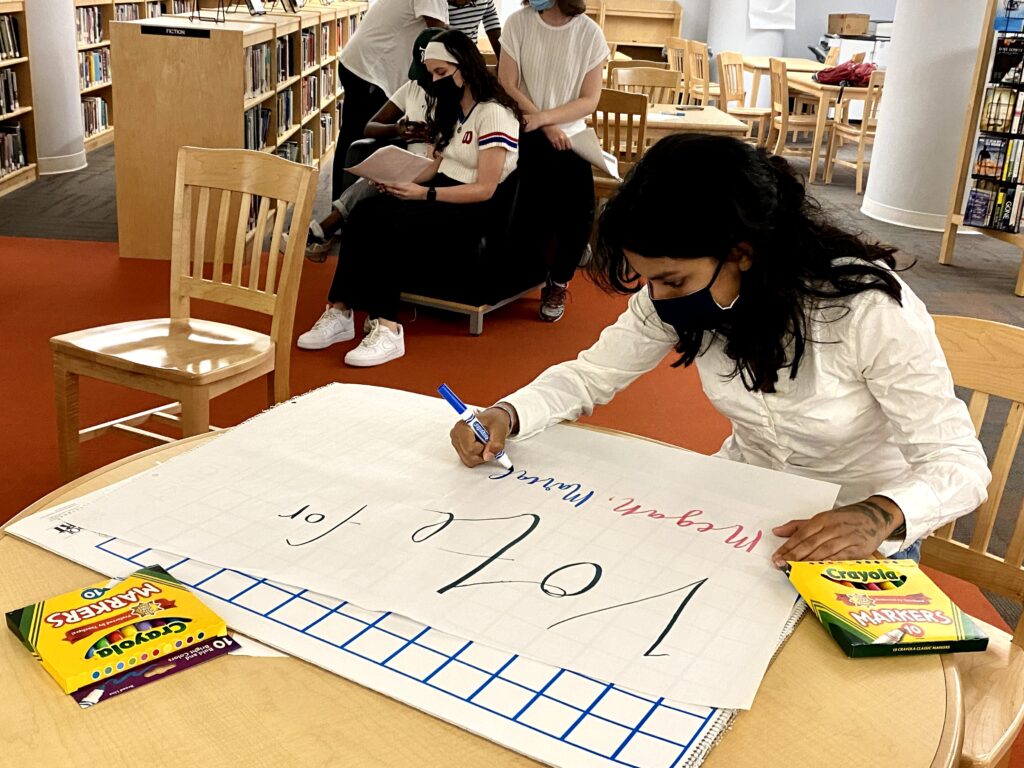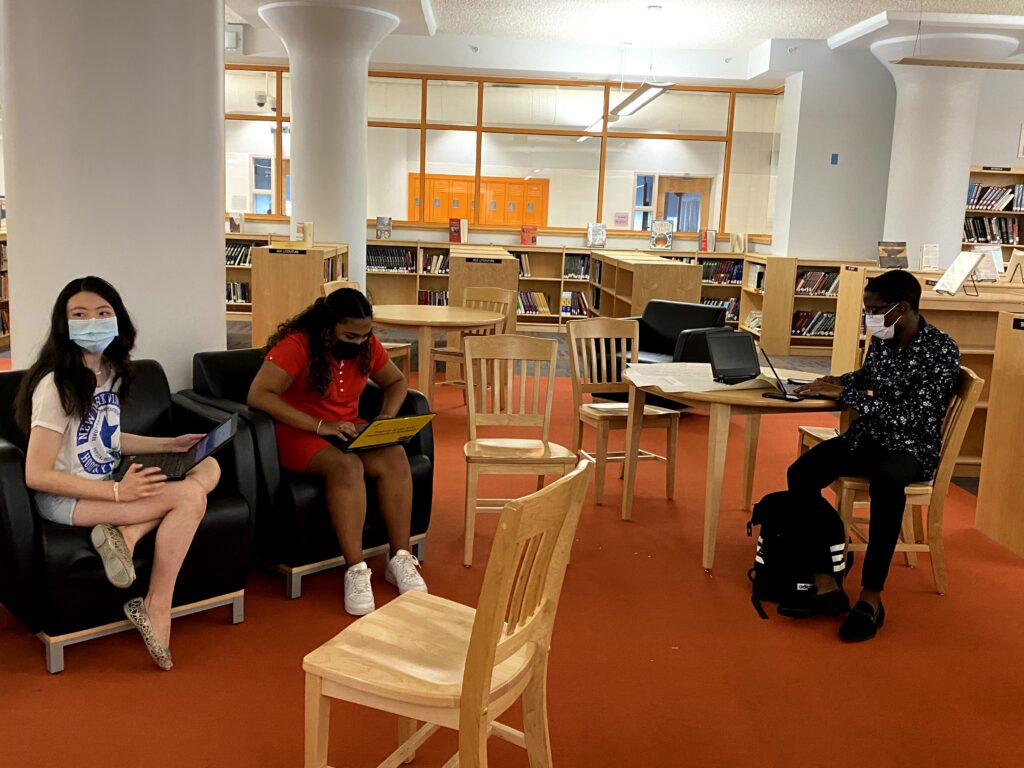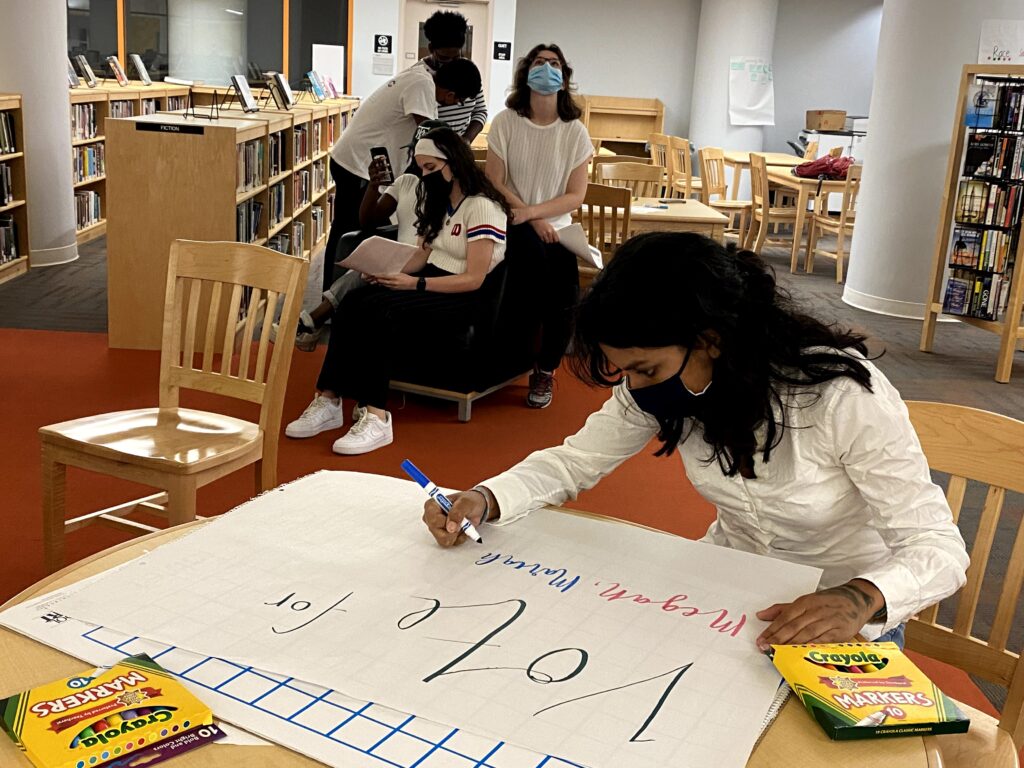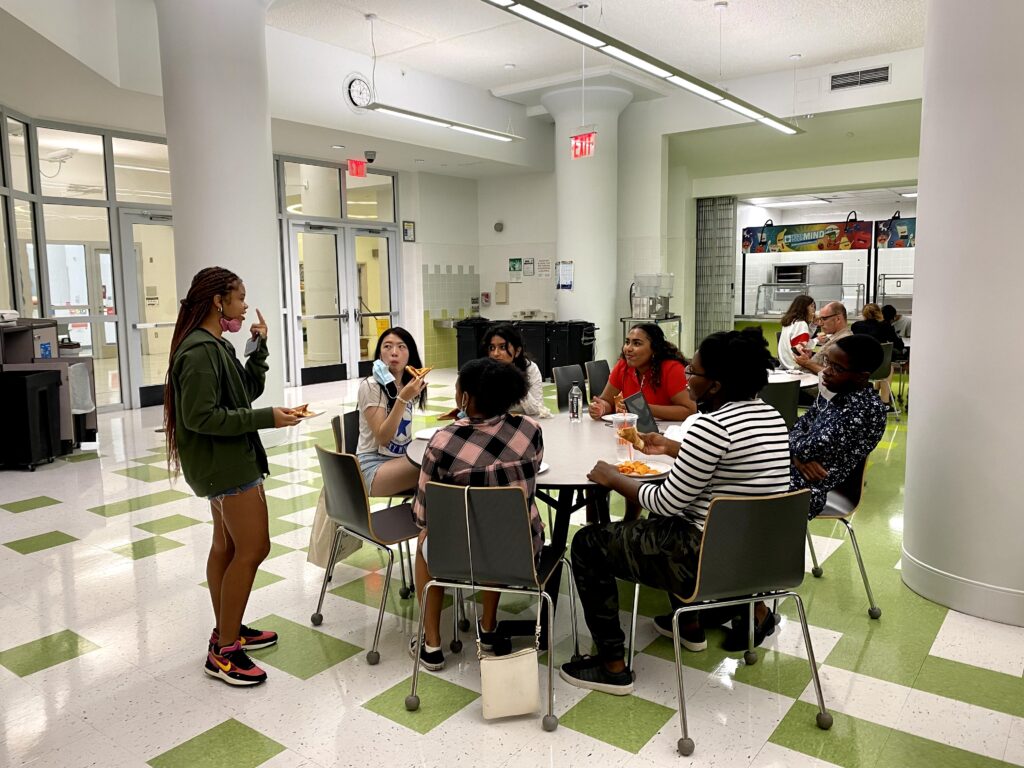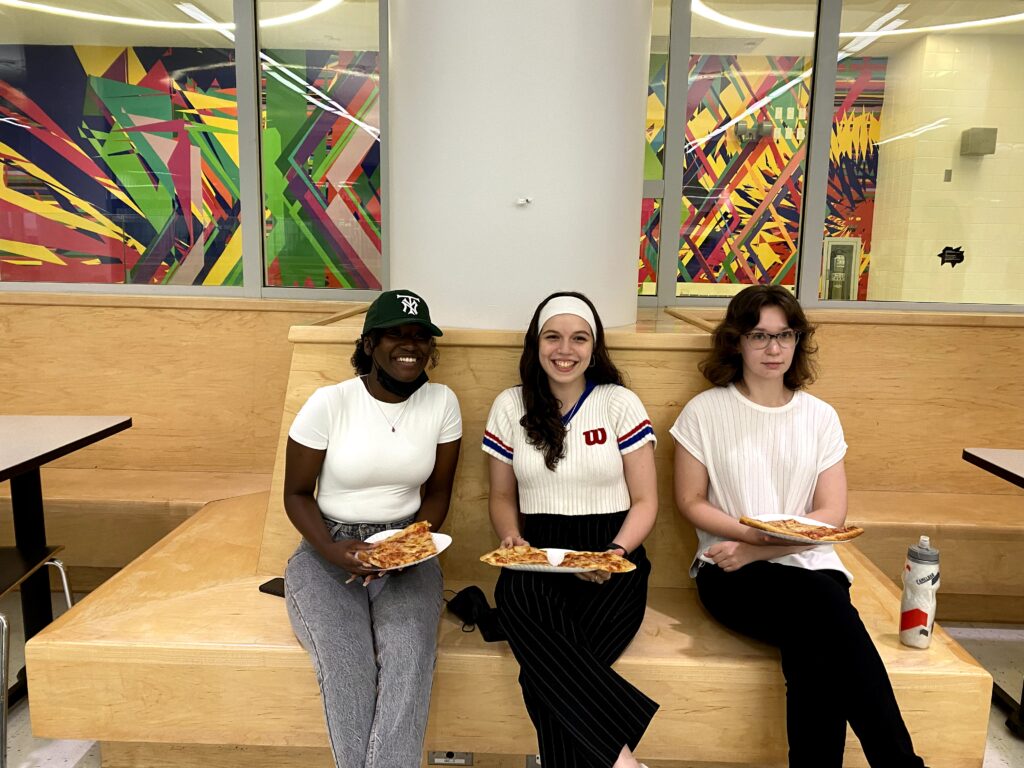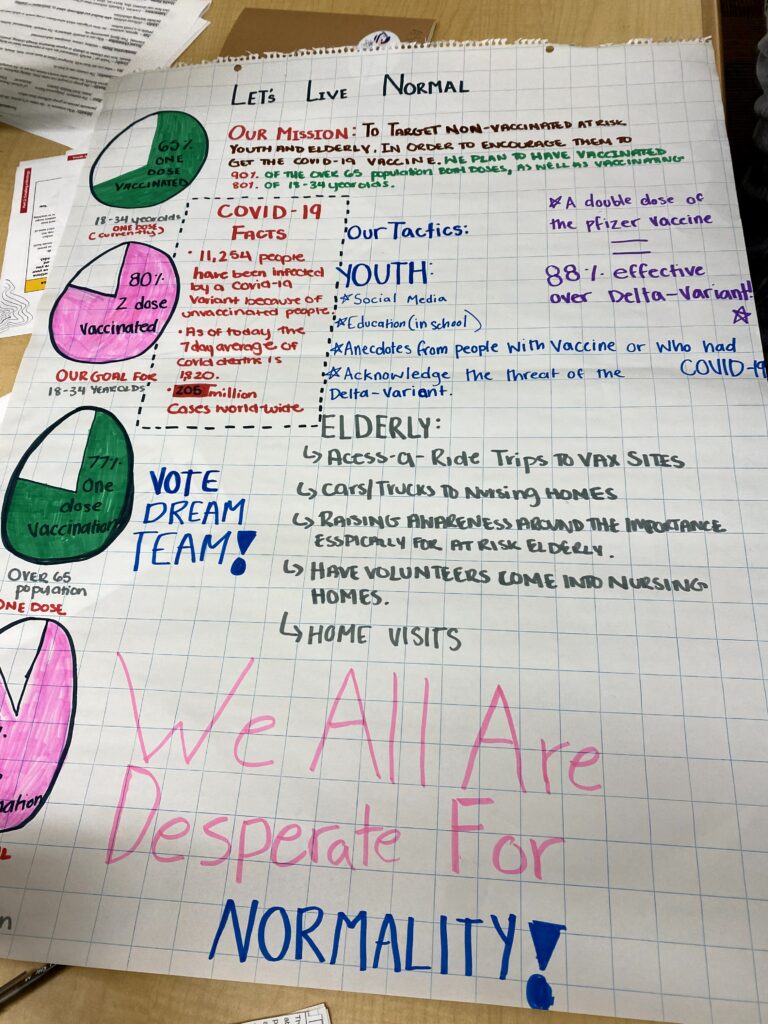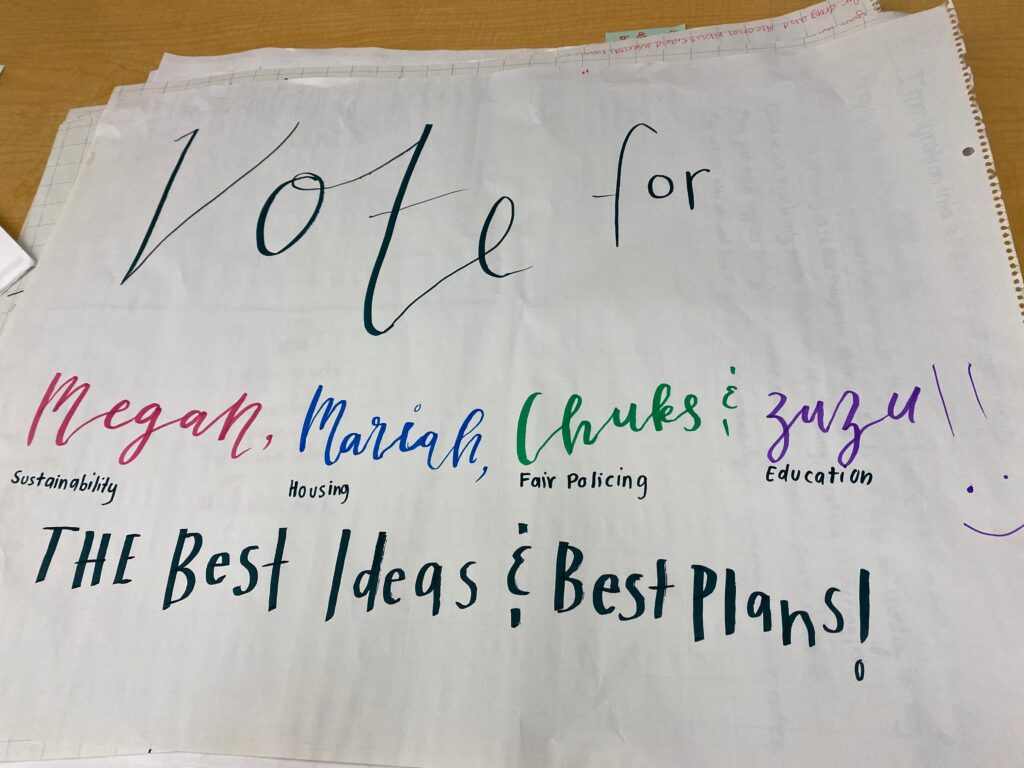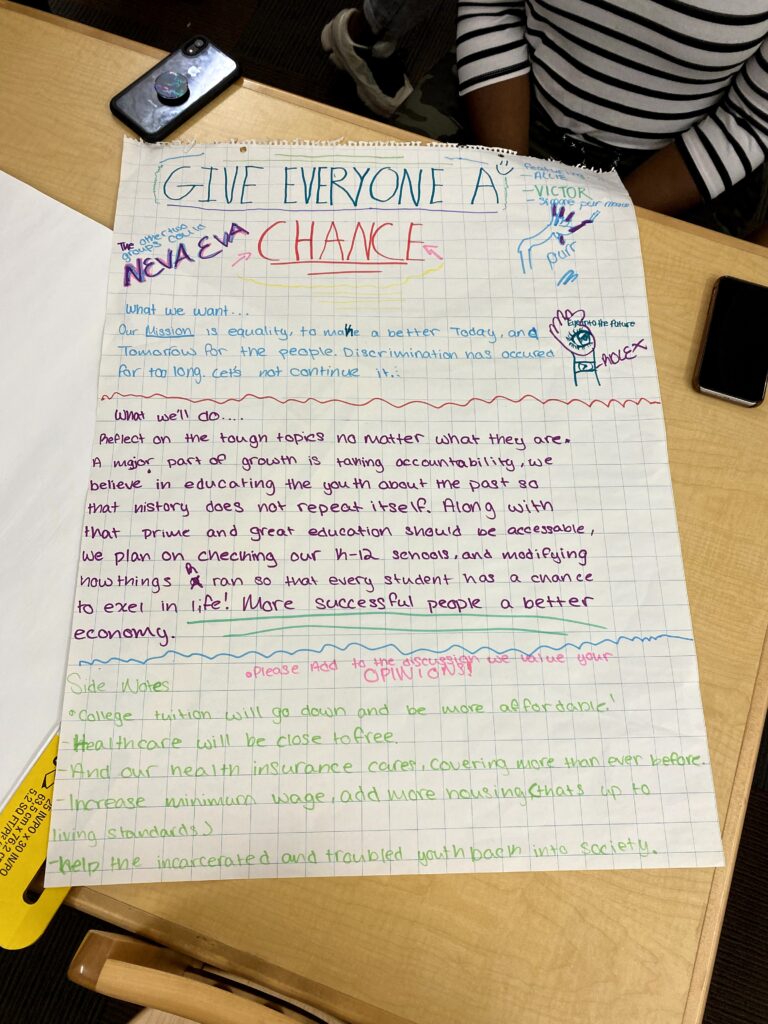What a treat to launch our second round of ChangeMaker Institute in the spacious, centrally air conditioned library of a state-of-the-art school building with a group of students eager to explore youth voting and civic engagement.
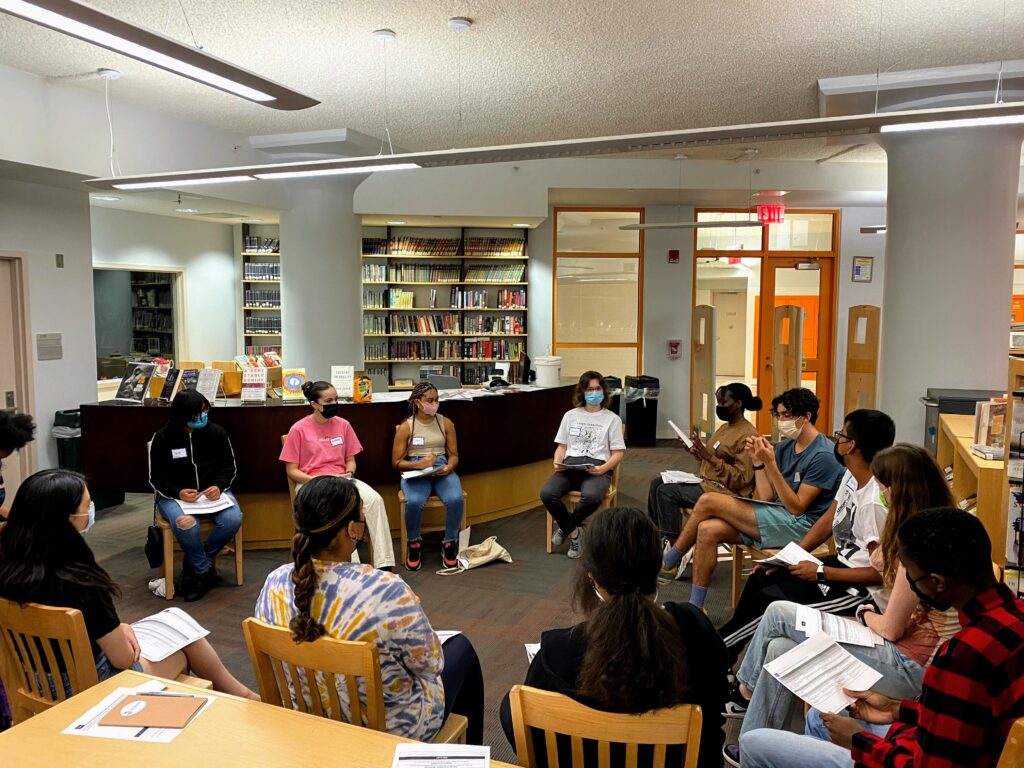
This marks the first experience most of the students, largely rising 9th graders and 10th graders, have had in the actual school building of Beacon High School, which is wild to consider. And there’s no one better to make them feel right at home than Chris-Ann, contextualizing YVote and sharing our Community Agreements for creating safe and brave space.
Of course the next most important thing is getting to know one another by each providing a “One Minute Intro” about ourselves. You’d be amazed how long one minute can be when you’re introducing yourself–and how much interesting information comes out. Here is Michelle modeling it:
Later in the morning, we engaged in Human Barometer exercise, with students standing in different ends of the room to signify if they strongly agreed, strongly disagreed, or were neutral about a series of statements like:
- I think anyone living in this country, regardless of citizenship or criminal record, should have an equal opportunity to vote.
- I think every citizen in this country has a responsibility (as opposed to the right or privilege) to vote.
- I think my vote will matter in the next election I am eligible for
They shared out about why they took the stand they did, and were encouraged to shift their place on the barometer if they heard things from a peer that changed their perspective in any way.
The afternoon began with a Whirlwind Ride Through 245 Years of Voting Rights–and Wrongs–in the United States, from our founding in 1776 through the recent Brnovich v. Democratic National Committee Supreme Court Case. Small groups engaged with key voting rights events from different periods, honing in on some key moments and enacting them–through timelines, arts, skits, spoken word, letters, and poetry. Check them out!
Equipped with recognition that the right to vote has always been a fight to vote, we analyzed a key part of this equation–power–having participants define power, analyze different ways power manifests within ourselves and within society, and explore four different forms of power: power over, power with, power to, and power within. We emerged feeling more power-full.
We closed out the day with reflections in our notebooks and one word responses to how each of us were feeling at the end of Day 1. We were gratified to hear words like “inspired,” “excited,” “energized,” “empowered” and “ready.” We did hear one “tired,” and we can relate!
Day 2 started in the energizing way all days should begin–with Kahoot! What better way to learn fun (ok, not so fun) facts about voting, voting rights, and voter turnout.
We played using the names of our favorite activists and wouldn’t you know it, Bernie won, followed by Greta Thunberg, followed by AOC.
Fully warmed up and riled up from what we learned in the Kahoot, we contextualized that at the core of our work in YVote is making space to have discussions about politics, sharing our experiences, and challenging ourselves to see topics and issues through diverse perspectives. This is why we’re called “YVote” –we look at the “why” and the “Y” (as an abbreviation for youth) and the role we can play in creating political change.
This entails participants having conversations with one another about their own experiences and thoughts around voting and civics AND having these conversations in their own circles to build a deeper understanding of what motivates or prevents young people to be actively engaged in politics.
In order to equip students to do so, we first explored how to get to know someone in a way that builds bridges.
We then brainstormed questions to ask people to foster juicy dialogue, first using non-political questions and then evolving into ways to get to know one another politically or civically–and doing so constructively! Questions like:
- When you turn 18, do you think you will vote in the elections you’ll be eligible for? Why or why not?
- Does your family talk about politics? Do they vote?
- Do you think the news and social media play an important role in how people feel about politics and voting? Explain how?
- What do you think will push or convince more young people to vote in federal, state, and local elections?
We interviewed each other with these while workshopping additional questions to see what kind of response they garnered and how to put people at ease so they will open up and share reflections authentically.
We re-energized after the lunch break with a Sing-Off. How many songs can YOU come up with that use the word “Love” or “Power” or “Justice”? Participants impressed us with their knowledge–and their willingness to sing in just about any key…

We spent the afternoon on Local Government, playing an interactive game to discern who does what–and who you’d contact if you need something done–as well as exploring why local officials matter, and what impact they have or could have on issues that matter to us in our communities.
This, of course, brought us back to POWER. We reviewed what we learned about power yesterday and then applied that to reading descriptions of and quotes about various local elected officials and their stances towards policing and applying that to a scenario about defunding the police. We reflected on each of the stakeholders and then power-mapped
- Level of Power: how much power does this person have over this area of politics. This can refer specifically to types of power they have
- Level of Support: how much they support or oppose the issue of focus
This really helped us visualize power flows–and why things do or don’t happen in our city!
Day 3 was all about Organizing and Building People Power! We started the day with a rousing round of Stand Up/Sit Down asking participants to stand up if, for ex,
- You or someone you know is a person of color who attends public school
- You believe that if you are old enough to fight in a war, you should vote
- You believe you should have the “freedom of expression” to voice your political beliefs at school, even if others object to them
As we stood, we looked at precedents where YOUTH have taken a stand to create social change, showing the slide of a youth-led movement that blazed the trail for the respective issue, for ex, the Children’s Crusade of 1963 that helped usher in greater desegregation of schools, and the effort to Lower the Vote in 1971, and Tinker vs DesMoines. We felt very inspired and galvanized by how much change young people have fostered! It led into a great conversation about misconceptions and stereotypes about youth.
We followed up on yesterday’s local government exploration by researching our local electeds from City Council to State Senate and Assembly Members–and sending each of them an email. Can’t hurt to know and develop a relationship with the people who represent us–and sure can help.
Next, we launched into a heady exploration of Problems vs Issues, defining what each is and how to distinguish between them. For ex, police brutality is an issue. Racism is the problem. Problems are big and can’t be fixed with a campaign. Issues are aspects of a problem that can be challenged with a campaign. They may be big, like getting the Voting Rights Act passed to try to ensure that people of color have the right to vote without being unfairly prevented, or smaller, like removing a racist school principal.
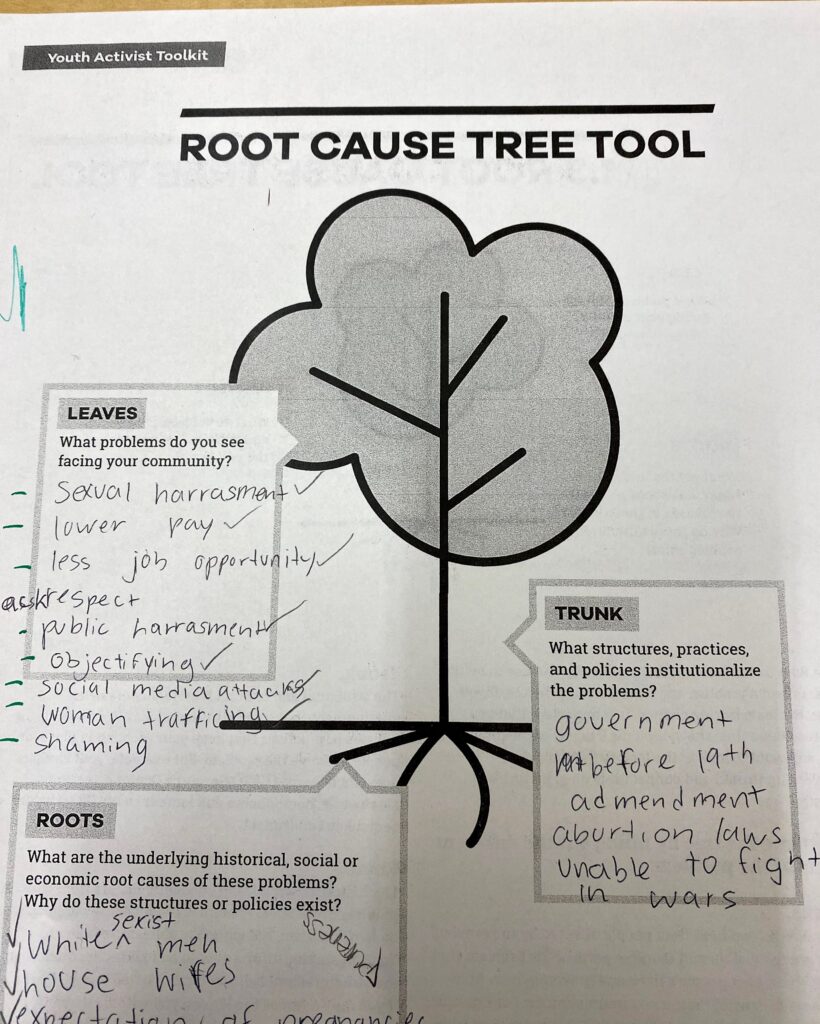
From this, we launched into designing Issue Trees to get to the root of our issues and to try to draw connections between what we see and experience today to the root/underlying causes as opposed to just symptoms and effects of the core issues. We were super impressed by the Issue Trees created by different groups:
Having created a garden of discontent, we proceeded to dig in (get it?) to exploration of what do we DO about this? How do we change the soil that our Issue Trees grow in? What role do or can voting and electoral politics play? What do WE need to know to make positive change? What do OTHERS need to know about our issues to make positive change?
After lunch, we discussed what community organizing is and the role it plays in politics. We honed in on the centrality of campaigns in successful community organizing. We broke down what campaign strategy entails, which basically boils down to, as the School Of Unity and Liberation (SOUL) says: A plan to organize your Folks and your Friends to force The Man to give you the Goods.
We defined each of these terms in relation to a scenario around Super Jails in the Bay Area, and how communities organized to create change against them using this framework.
We ended the day by engaging with an all-too-real scenario about the condo collapse in Surfside, FL and what we would do if we lived in that city. We read four sets of actions and asked students to take a stand in four different parts of the room based on which stance they resonated with. All four were represented with passionate rationales. Each represents a certain archetype of activist–(1) Helpers, (2) Advocates, (3) Change Agents, (4) Rebels–and led into WHY we chose the response we did; what we thought about the other responses; how our particular role is or isn’t critical in making social change happen; what’s challenging when working with people from the other groups/who would take a different approach; and how we think others would view us and perceive challenges working with us. It was an eye-opening and fascinating conversation!
Day 4–hard to believe this marks the end of the first week! Today was all about community, after an opening icebreaker about what our respective super powers would be (mind control, time travel, and teleportation were particularly popular…)
We started by having participants share how they define community and then shared a definition we love:
“Community is a place to practice and participate in care, attention, knowing and being known, being protected, having room to make mistakes and still belong…not just allowed to be there, but be valuable…to heal. to recover. Community feels responsible for each other.”
and another
“Community is a choice. More precisely, community is an accumulation of choices made every day, a set of growing practices.” – Adrienne Maree Brown
So what does a strong community look like and feel like? Chris-Ann led us through a guided meditation to help us visualize it and “visceralize” it. It certainly got students to a zen place!
We took this to the next level through creating more collective visions of community, with small groups creating vision of their ideal communities, and deciding how they would provide: Food, Safety/Justice, Education, Health, Housing, Government/Politics. Check out their inspiring examples:
To work towards the ideal, we have to first ground ourselves in the real. We discussed our present state communities in trios discussing questions like:
- what do you love about your community? What would you keep? What makes your neighborhood special? What are the strengths / positives that people perceive about your neighborhood? What are the perks to living there?
- what don’t you like about your community? What would you change? What are the weaknesses / negatives that people perceive about your neighborhood? What needs of community members are not currently being met?
And then we went to lunch (the food was much less good than it will be in our ideal community…
We reconnected after lunch with a Neighborhood Face-Off, expressing why our community is better than the others. What do YOU think is the best borough of NYC? Our students had STRONG feelings about this
Having expressed our personal experiences and beliefs, about our communities, we evolved to focus on community data, discussing why data is important when talking about problems and solutions and how we can use data to identify what is and isn’t working in our communities.
We also discussed how large data collection efforts can help us see the big picture by providing a significantly greater sample to indicate what major issues we need to prioritize, as well as what’s effective so we can continue to support those actions.
Fortunately, there is a GREAT data source available through the Citizens’ Committee for Children’s Keeping Track Online, one of the largest public databases that compiles statistics on child-wellbeing. This database enables us to look at lots of different statistics like student test scores and high school graduation rates, juvenile arrests, teen pregnancy, how many children are homeless or in foster care. We can also look at the assets (or strengths!) in a community such as schools, parks, health and mental health services, and afterschool programs.
Students took time to look through their neighborhood’s data and cross reference it with other neighborhoods, which was just as fascinating as you’d imagine it to be in a city as diverse as NYC with so many disparate realities. We looked at Community Risk Rankings to discern where there is greatest need for support and improvement across factors.
This provided soil and a seed bed for us to start to brainstorm about the campaigns we will be building next week. In small groups, we discussed and charted
- What are the top issues / problems that youth (ages 14-22) in NYC face?
- Where do issues / problems take place that youth (ages 14-22) in NYC face? Where are youth the most vulnerable or likely to face issues?
- How do the issues / problems that youth (ages 14-22) in NYC face occur? What are the forces / causes behind them? Who is to “blame” or responsible for addressing them?
What will this all lead to? Stay tuned next week!
Week Two–what a difference a week makes. Walking in this Monday is walking into a community. And a community re-energized after the weekend. Which is good, because we’ve got a packed week ahead.
Today’s focus is on Elections, starting with a rousing round of Show Me the Money
Our goal was to try to make NYC’s budget (which is $98.7 BILLION dollars for FY 2021 (nearly 100 billion) real and tangible–in a fun way– by 1) making them instant millionaires with $10 million and 2) asking each participant to decide how to allocate their $10 million across all the city categories (and anointing a few to have veto power and the ability to redirect money):
- Housing
- Law Enforcement
- Fire Department
- Parks and Recreation
- Education K-12, College and Universities
- Transportation
- Public Health and Hospitals
- Sanitation
- Social Services (Elderly, Homeless, Child Abuse Prevention, etc)
- Cultural Events and Museums
- New Initiative – area / project of your own design
Turns out the money goes reeeally quickly!
We had a very rich discussion of why we made the choices we did, and the implications of funding as we did.
So how did our funding match up to reality? We checked out What $10 Million Buys, which was sobering. For example, it could get us either:
- 7 fire ladder trucks
- 1,377 child care vouchers (out of 67,420)
- 132 new teachers
We closed out this section by discussing that although we don’t have $10 million each to allocate, there are a variety of ways to influence the city’s budget, such as:
- Voting for candidates who support your ideals and commit to addressing your concerns
- Testifying in public hearings
- Participatory Budgeting
OK, so how does this all connect to voting? We delved backed into themes we started to discuss last week, sharing our thoughts about why so few Americans, esp young Americans, poor Americans, and Americans of color, vote in elections.
We found that most of the reasons they listed for why people don’t register and vote fit into one of three categories.
| 1) People don’t vote because institutions keep them from doing so | 2) People don’t vote because voting is too difficult (limited access to polling places, lack of safety, it’s confusing, it’s too time consuming) | 3) People don’t vote because they don’t think their vote makes a difference |
We asked participants to go to different parts of the room to demonstrate which they think would be the biggest barrier for them and their generation, with people split across all three.
We explored key terms like disenfranchise, voter suppression, electoral fraud, and gerrymandering–terms which can be a big barrier to understanding much as their counterpart phenomena are a barrier to voting itself.
We split into pairs to engage more concretely with barriers–and solutions to those barriers–through engaging with
We then categorized all the barriers we read about under the category of the three that it best fits–People don’t vote because institutions keep them from doing so; people don’t vote because voting is too difficult (limited access to polling places, lack of safety, it’s confusing, it’s too time consuming); or people don’t vote because they don’t think their vote makes a difference
We processed our emotions about the barriers that people face exercising their right to vote to this day, discussing what is surprising, interesting, frustrating.
There’s a message we hear a lot: the system is rigged, or one vote won’t matter, or politics doesn’t really affect my life. When these messages are particularly targeted to certain communities, they become a form of voter suppression.
We have to understand history–and intersectionality–to make sense of all of this. The 15th Amendment provided the right to vote to black men without actually ensuring that they could exercise that right. The 19th amendment provided women the right to vote without ensuring it for Black women
Often, when we talk about voting and voting rights, it can feel like settled history: “A long time ago, not everyone could vote. But we spoke up, and we protested, and we changed the laws, and now everyone has equal access to elections.” Wouldn’t that be great???? But there’s a lot more to the story than that.
Voting has been far from a guaranteed right–the right to vote has always been a fight to vote
It’s important to see the full picture. It is NOT a story of continuous progress, with voting rights expanding steadily and slowly over time. Seeing all of the ways that voting laws can be changed shows a more complicated journey, which is a lot more illuminating.
To bring numbers further to life–a theme of our morning–we engaged in a 10 Chair visualization, reading out statistics and asking the # of people represented in the stat to sit in the chairs. For example, in 2016, 4 out of 10 youth ages (18-29) voted, so participants occupied just 4 out of 10 chairs. Looks pretty empty–which can be motivating to fill those seats better next time.
We also tried to put the numbers in perspective. So in our most recent election in 2020, 5 out of 10 youth turned out. This is just one more seat filled, true, but it equals an 11% increase from the past presidential election. We drilled deeper into the data as well: an estimated 1.3+ million youth voters voted early in 2020, which is higher than the TOTAL (inclusive to all forms of voting) of youth voter turnout in 2016 !!!
It was heartening to see how much progress there has been–and how much more there needs to be.
After lunch, we focused on a key part of any campaign: making demands. Most social justice campaigns have goals that shift power to people who are directly impacted and provide solutions to structural / cultural causes of the problem. Another word used for these campaign goals is demands.
A demand is ultimately a specific policy change or action that one seeks to win from a decisionmaker. Chris-Ann guided us through some examples. She reminded us that solutions should directly connect to a specific issue, a measure taken to end harmful actions AND/OR provide resources for the people impacted by those harmful actions to create sustainable change
- Have the group form pairs and practice shaping demands based on issues (provide examples on chart).
- You may also prompt people to look back to their problem trees to help brainstorm
- Chart out the responses of the group
To apply and synthesize these concepts, we paired up to practice creating demands based upon issues, referring back to our problem trees to help brainstorm. We considered demands in response to things like Inequality in Education; Police Brutality; Discrimination against LGBTQ+ Students in schools; Immigration Justice; and Voter Suppression.
And then it was time to move onto creating SMART Goals for our campaigns. Using SMART goals allows organizers to create strategies that are effective and help galvanize the support needed to be successful. SMART goals help us “cut the issue” which means turning the issue into “bite-sized” issues that guide your strategy.
In teams, we brainstormed potential goals THEN apply the SMART goals framework to shape goals into stronger demands through making them Specific, Measurable, Achievable, Realistic, and Time-Bound
Quick Review of SMART Goals (optional powerpoint to guide here): take examples from the group for each.
We ended the day with a sneak peek of each group’s campaign goals, demands, strategies, and slogans. They’re coming together impressively!
Day 6 focused on Media and Messaging, with a very strong emphasis on Identity. Given how personal these issues are, we didn’t record much video.
Day 7–Today we focused on Campaign Strategy. We started with an nontraditional campaign: to flip a blanket. Yes, small groups of participants gathered on a blanket and had to try to flip it over without anyone stepping off the blanket. If anyone in the group stepped off the blanket, they had to start over again.
It feels impossible–but it’s not. Which is part of the magic, as expressed by Mariah here.
Onto Strategy and Tactics, starting with a recap of Campaign Strategy from Organizing 101.
Michelle helped us hone in on tactics. Tactics are the specific steps and actions that campaigns take to put pressure on their targets and reach their goals. We asked the group to share some examples of tactics they see social justice movements use, and charted responses, from Protests to Marches to Rallies to Petitions to Lobbying to Walkouts.
We broke out into groups to discuss the effectiveness of some popular tactics, and compare them to one another–for ex, Petition and Marches, Rallies and Lobbying; Walkouts and Workshops; Social Media Campaigns and Blockades. Each team discussed: What are the differences between the two tactics? What makes these tactics effective–or ineffective? When would using them be the most useful for your campaign? When wouldn’t you use these tactics, or when would using these tactics be least useful for your campaign? How much pressure would this apply to elected officials and why? How much effort does it take to pull off and how risky is it for your supporters? And then, of course, we shared our work
Fortified with our increased understanding of comparative tactics, Anna led us through a brief exploration of when, where, and how to use different tactics.
Time for Escalating Tactics Battle! In campaigns, organizers sequence tactics using escalation to build power and continue to put pressure on decision-makers.
As we explored through examples, some tactics are most effective in the beginning of a campaign because it builds awareness and support for your issue while taking the least amount of effort, and others are more effective later in a campaign when decision-makers are refusing or delaying meeting your demands.
To help us visualize what escalating tactics look like, we divided the group into 2 teams and had them line up facing each other. We assigned them tactics to act out for their team members to guess aloud, as the opposite team did the same. The first to guess correctly gets the point, and the points are meaningful because whoever gets the most points, gets the prize. Which it turns out is a very meaningful incentive.
Needless to say, things got competitive…
And the teams got VERY good and very quick at acting out and guessing tactics.
Until the final round–a tougher tactic–with a tie score between the teams and high stakes.
As always, the debrief is everything.
Next up, base building, with a great overview by Anna. She explained that one’s base is the people who are directly impacted by your issue, people who are a part of the community being targeted by the issue or where the issue takes place. Your base is also a large group of supporters who you can call-to-action when you’re implementing your tactics. Base-Building is recruiting new people into your organization, having it grow in members and raising awareness of the organization. Basebuilding is not just one step, but a process that involves outreach, follow-up, recruitment and building a relationship with new, existing, and potential members.
Base-building is synonymous to “building collective power” or “power with” as we discussed in last week’s workshop on power. Decision-makers are more likely to pay attention to your issue when more people are involved in one’s cause… think of how the #blacklivesmatter protests after George Floyd was murdered by police began to shift the response of elected officials and other powerful people around this issue.
At root, why do people join campaigns–or why don’t they? Chris-Ann led a rousing discussion of this make-or-break variable
There’s a simple but profound equation at the core of it: Anger + Hope = Action. Harnessing that is powerful!
Next, Michelle led us in a discussion of recruitment approaches, asking participants to think about ways they can build their base in school or community, and ways they can access and outreach to the people who may support.
Time to apply this new found knowledge to action through working on our “recruitment raps” using the formula we just reviewed.
Here’s the scenario: Imagine you are tabling at a fair and a person walks up to your table and is interested in knowing more about your cause and how to get involved.
We encouraged participants to take a minute or two to think about what they would say to the person, how they would engage them in conversation, what they would ask them to understand the other person’s own position, and how they would get them to sign-up.
They then paired up, with Partner A serving as the recruiter and Partner B as the recruitee in the first round. They had 2-3 minutes to do the convincing, and Partner B to raise their hand if/when they felt they were convinced to join. Needless to say, we have a pretty convincing group–and a pretty skeptical group.
Of course we debriefed by sharing reflections about what makes an effective recruitment rap? What was challenging about recruiting someone–because we all know it is? How would they follow-up this form of outreach to keep people engaged with your movement?
In closing this section, we underscored that building power is a key part of the work campaigns do. A lot of effort and resources go into building a base which includes workshops, training, and social events to strengthen the ties / bonds people form with the community. People want to feel connected and productive, and those who do can become strong leaders and supporters for a cause they believe in.
After lunch, we split into our Campaign group to nail down our respective strategies
We spent the rest of the afternoon working on our campaigns to prepare for a culminating Civic Shark Tank tomorrow!
Day 8–hard to believe this is our LAST day together!
After our morning circle and reflecting on what of the Community Agreements we’ll carry forward and how, we launched the day with a powerful power line activity, through which they had to silently line up by height, by age, and by skin tone, being told to face the front of the line after each round–which as you can imagine was enlightening.
Interesting conversations ensued, which were a great segue into our Power, Privilege, and Oppression activity, defining each of those terms and then delving into the 3Is of Oppression
- Internalized Oppression (Values, beliefs, feelings): Oppression that happens when a person really BELIEVES that the negative stereotypes about their own group apply to themselves.
- Interpersonal Oppression (Actions, behavior, language): Oppression that happens between people. Interpersonal oppression can manifest in interactions between people within the same oppressed group, between people from different oppressed groups, or between people from an oppressed group & a privileged group.
- Institutionalized Oppression (Rules, policies, procedures): Oppression that comes from institutions of power in our society, such as the government and corporations.
We had a REALLY meaty conversation about how these manifest in our lives and the world:
To help participants internalize and apply understanding of these three Is, we broke up into teams of three, each of which was given a different set of cards with scenarios on them and asked to discuss and decide which “I” it represents. Another interesting debrief ensued
The afternoon was quickly approaching, so we split into Campaign Teams to finish up work on our presentations–that is, after a mini-lesson on effective pitches that included watching one of the most successful pitches of all time–for Scrub Daddy–and thinking about implications for OUR presentations this afternoon.
What’s a last day without a pizza party…and a rousing game of “Ask Your Facilitators Anything”?
The time we’d been waiting and working for arrived. Check out the campaign pitches for each of our three groups:
Their questions to one another–and their responses to each other’s questions–were as good as the presentations they prepped for:
We’re proponents of democracy and voting, so of course we had to have a transparent and equitable voting process:
We did the big reveal Survivor style, announcing each vote, and at the end, it turned out…we had a dead-heat tie between the A City That Works for Everyone team and the Covid19 Dream Team. What to do, what to do? We had the three members of the Give Everyone a Chance team decide by majority rule (they had a 2/1 split between them). And the winner is…
Revelry ensued, and good sportsmanship was demonstrated by all–professional politicians could learn a thing or two from our ChangeMakers…
It was an incredible week together, culminating in a powerful closing circle in which we each reflected on what we’ve learned, how we’ve grown, and what we appreciated about the experience.
We can’t wait to see what these change makers go on to do!
